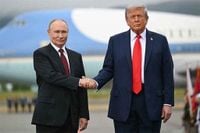When Donald Trump swept into office with his trademark bravado, he made a bold promise: he would end the war in Ukraine within 24 hours. Now, six months into his presidency, that pledge has collided with geopolitical reality in a dramatic summit with Russian President Vladimir Putin, held on August 16, 2025, in Alaska. The world watched as two of its most polarizing leaders met face-to-face, each hoping to shape the next chapter of a conflict that has already redrawn the map of Europe and tested the resolve of the West.
In the lead-up to the summit, tensions were running high. According to Countercurrents, Congress was already preparing to push for an additional $54.6 billion in weapons for Ukraine, underscoring the stakes if negotiations faltered. Meanwhile, on July 28, former Russian President Dmitry Medvedev took to social media to denounce Trump’s latest threat—an ultimatum to end the war—as “a step towards war.” In response, Trump posted on Truth Social that he had ordered two U.S. nuclear submarines to be “positioned in the appropriate regions,” a move that John Bolton, Trump’s former national security adviser, called reckless escalation. But as Safehouse Briefing noted, such declarations were more about spectacle than substance, with Putin’s spokesman dryly remarking, “In this case, it is obvious that American submarines are already on combat duty.”
For Trump, the Alaska meeting was another chance to project strength and control the narrative. Yet, as Brian O’Neill, a former CIA executive, observed in Safehouse Briefing, “Trump mistakes bravado for deterrence, bluster for backbone.” The summit was billed by the White House as a “listening exercise,” but for Ukrainian President Volodymyr Zelensky, it was a “personal victory” for Putin—a sign, perhaps, of just how fraught the diplomatic landscape had become.
Putin, for his part, used the occasion to frame the historical moment. Emerging from the summit, he said, “This was a very hard time for bilateral relations and, let’s be frank, they’ve fallen to the lowest point since the Cold War. I think that’s not benefiting our countries and the world as a whole. Sooner or later, we have to amend the situation to move on from confrontation to dialogue.” According to Countercurrents, Trump responded by promising to consult with NATO leaders and Zelensky, presenting the U.S. as an impartial mediator—even as Washington continued to provide weapons, intelligence, and political support to Kyiv.
The Alaska summit was not the first step in the diplomatic dance. Back on February 18, 2025, senior U.S. and Russian negotiators had agreed on a three-step plan: first, to restore diplomatic relations; then, to negotiate peace in Ukraine; and finally, to address the broader breakdown in U.S.-Russia relations. Trump and Putin’s decision to meet now was a recognition that the deeper rift between their countries needed to be addressed before any stable, lasting peace in Ukraine could be achieved.
Yet the situation on the ground in Ukraine remained grim. Russia has waged a grinding war of attrition, focusing on destroying Ukrainian forces and equipment rather than seizing vast swathes of territory. Notably, Russia still has not occupied all of Donetsk province, which declared independence in 2014 and was officially annexed by Russia ahead of the February 2022 invasion. Ukrainian troops, spread thin along a 700-mile front, sometimes number as few as 100 soldiers over several miles of defenses. According to Countercurrents, a major Russian offensive could threaten the collapse of the Ukrainian military or even the fall of Zelensky’s government.
Behind the scenes, the U.S. and NATO have maintained a significant presence, operating from the joint Ukraine-NATO war headquarters at the U.S. military base in Wiesbaden, Germany. There, Western troops coordinate with Ukrainian forces, plan operations, and help target missile and drone strikes. If the conflict were to escalate further, Wiesbaden itself could become a target for Russian missiles—a chilling prospect, given that NATO missiles already target bases inside Russia.
Despite the high drama, many observers questioned Trump’s approach. As Safehouse Briefing reported, Trump had a pattern of making threats—like imposing punitive tariffs or setting ultimatums—only to back down or declare victory prematurely. His air strikes in Yemen earlier in the year were quickly followed by a ceasefire with little strategic impact, and the much-touted June strikes on Iran’s nuclear facilities came only after Israeli air campaigns had already neutralized much of Iran’s air defense. Medvedev, in his social media post, was blunt: “Russia isn’t Iran.”
For many Ukrainians, patience with the war is wearing thin. A recent poll cited by Countercurrents found that 69% of Ukrainians now favor a negotiated peace, fearing that their position will only worsen if the conflict drags on. The neutrality agreement that the U.S. and U.K. rejected in April 2022 would have included a Russian withdrawal from newly occupied territory, but Western leaders instead promised a long war to weaken Russia—a strategy that, in hindsight, may have backfired. As Countercurrents pointed out, “every time the U.S. and NATO prolong or escalate the war, they leave Ukraine in a weaker position, not a stronger one.”
Meanwhile, European leaders have talked tough but stopped short of sending their own troops to Ukraine, apart from small numbers of special forces and mercenaries. Putin, in his post-summit remarks, urged European capitals to approach the negotiations constructively and not to “throw a wrench in the works” or provoke further escalation.
The Alaska summit may not have produced an immediate breakthrough, but it did mark a turning point. According to Russian aide Dmitry Medvedev, Trump “refused to escalate tensions” during the meeting, a stance that Medvedev interpreted as a Russian victory. In the aftermath, Trump hinted at possible troop cuts as a way to pressure Kyiv and Moscow toward peace, while his aides privately conceded that “Putin clearly won” the Alaska talks—describing them as “one-sided.”
So, where does this leave the world? The answer, as always in geopolitics, is uncertain. Trump’s showmanship may have once been enough to unsettle adversaries, but as Safehouse Briefing warned, “If your adversaries know you bluff compulsively, they stop believing your threats—even when you mean them.” The challenge now is to move beyond theatrics and toward the kind of credible, coherent diplomacy that can deliver real results—not just for the U.S. and Russia, but for Ukraine and the world.
As negotiations continue, the stakes remain enormous. The choices made in the coming months will determine not only the fate of Ukraine, but also the future of U.S.-Russia relations and the broader global order. For now, the world can only watch—and hope—that this time, the rhetoric gives way to real progress.




